
archives for 02/2009
 It's been a month since the deer chomped on
the last of our winter greens, and despite the tasty summer treats I
pull out of the freezer I'm starting to crave fresh vegetables.
So I went out to peer into the cold frame which I planted with lettuce
and spinach on October 29.
It's been a month since the deer chomped on
the last of our winter greens, and despite the tasty summer treats I
pull out of the freezer I'm starting to crave fresh vegetables.
So I went out to peer into the cold frame which I planted with lettuce
and spinach on October 29.The salad greens were supposed to be big enough to eat in December, but some cold spells knocked them back. Now they're starting to grow! Still not quite big enough to eat, but both are starting to put out fresh leaves. Maybe in a couple of weeks....
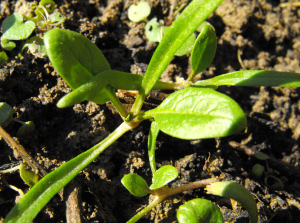 Meanwhile, I planted my traditional
Groundhog's Day lettuce bed --- a couple of days early because even
though the ground isn't what I'd call dry right now, it's only going to
get wetter come Monday. I've been curious about whether the
southwestern Native Americans' method of pit gardening would be useful
to give my salad greens a bit of insulation in the winter, so I made
half of the new bed a pit garden and the other half a raised bed.
(Both are inside a cold frame covered with row cover fabric.) In
a couple of months, I'll let you know the results of the side by side
comparison!
Meanwhile, I planted my traditional
Groundhog's Day lettuce bed --- a couple of days early because even
though the ground isn't what I'd call dry right now, it's only going to
get wetter come Monday. I've been curious about whether the
southwestern Native Americans' method of pit gardening would be useful
to give my salad greens a bit of insulation in the winter, so I made
half of the new bed a pit garden and the other half a raised bed.
(Both are inside a cold frame covered with row cover fabric.) In
a couple of months, I'll let you know the results of the side by side
comparison!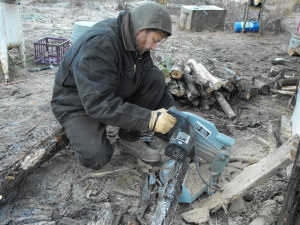 The chainsaw is still having a power problem,
which makes me wonder if I was wrong about having bad fuel in it last
week?
The chainsaw is still having a power problem,
which makes me wonder if I was wrong about having bad fuel in it last
week?
Plan B is to use the miter
saw to cut up some long and narrow pieces of walnut and box elder
we've had laying around.
Using the chainsaw on these smaller pieces has always seemed like
overkill to me and often resulted in some odd angles you have to hold
the saw in which sometimes leads to having your chain touch the
dirt...which is a very bad thing and causes the cutting portions of the
chain to not cut as well.
I was pleasantly surprised at how easy it is to line up and cut these
tiny logs into a decent pile of firewood.
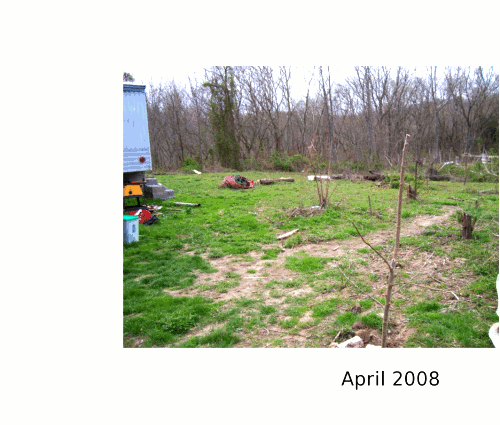
Actually, my apples hardly needed pruning. I only have one good one --- the winesap shown here. I bought it last April from Lowes, pruned it within an inch of its life so that its branches would match its roots, and then ignored it. I didn't really believe it had grown, but when I took a look at the side by side comparison, it become clear that the winesap actually did quite well. Maybe we'll have apples in a few years!
Tender Crops
in Last
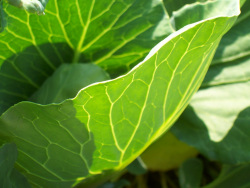 The most tender crops, pole
beans and limas, go in last while pepper
plants and eggplant are set out.
The most tender crops, pole
beans and limas, go in last while pepper
plants and eggplant are set out.
At the very last I sow
winter squash --- not more tender, really than
the summer types which won't, however, be harvested until fall.
The small varieties are better for the backyard garden than Blue
Hubbard, while the dark-green, heart-shaped Quality now rates higher
with me than Butternut. It was even more vigorous growing in last
summer's drought than Butternut, and far more prolific. The
average fruit weighed 5 to 6 pounds, only one weighed 10, and it was
just as disease-resistant. Quality's chief virgue, however, is
the marvelous flavor of its fine-grained flesh. It can be eaten
immature, skin and all. Buttercup also has good flavor, but in my
experience is more susceptible to disease and insect attacks. I
also plant a few hills of Small Sugar pumpkin whose flesh is not
stringy, and which are good both for decoration and for pies. Read more....
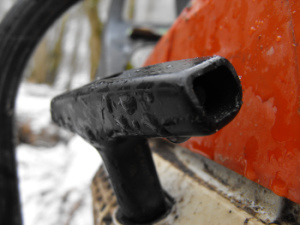 The chainsaw is once again ripping through
logs like a hot knife cutting through butter.
The chainsaw is once again ripping through
logs like a hot knife cutting through butter.
It turns out I was on the right track with suspecting the fuel as the
culprit. The key was in the symptom details. The engine sounded and
felt like it does just before it runs out of gas.
The only thing I did to get it to work this time was bring the fuel
canister in the trailer for a few hours before filling it up. I had
been storing it outside, which seems to be the root of my problem.
Maybe it has something to do with the oil and gas mixture? My
conclusion is to just keep the can of mixed gas inside along with the
chainsaw and everybody stays happy and warm.
The gardening season has
begun! I checked over my spreadsheet to plan out the month of
February, and thought those of you in a similar zone might get
something out of a rundown of the tasks:
- February 2 --- plant lettuce and spinach in a cold frame.
- February 14 ---
- plant snow peas in
the sunniest spot in the garden. Shelling peas never seem to
survive
this early for me, and even the snow peas are a gamble (so don't plant
all your seeds), but if they
survive you'll have bragging rights at the feed store!
- indoors or in a cold frame, start cabbage and broccoli.
- Before
the end of the month --- cut logs to innoculate
with shitake spawn. (But don't innoculate yet!)
Doesn't sound like much,
I know, but it's exciting to be able to start growing again! Keep
in mind that this is for zone 6 --- your dates will vary slightly.
Harvesting in
June Before Summer Has Begun
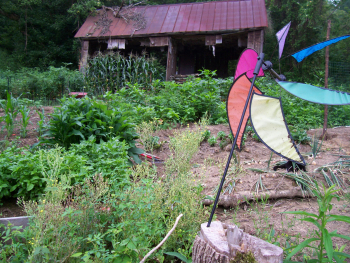 By the calendar, summer has
not yet begun. What am I harvesting
in June? Not many things, but plenty of each kind.
Asparagus still, peas every day, also lettuce, radishes, beet and
turnip greens, scallions, baby carrots. One may tire of stored
canned peas every day or store-bought asparagus, but garden-fresh
vegetables keep the appetite from getting jaded. In winter, I
look forward to the June harvest --- which includes strawberries --- as
the finest of the year. Read more....
By the calendar, summer has
not yet begun. What am I harvesting
in June? Not many things, but plenty of each kind.
Asparagus still, peas every day, also lettuce, radishes, beet and
turnip greens, scallions, baby carrots. One may tire of stored
canned peas every day or store-bought asparagus, but garden-fresh
vegetables keep the appetite from getting jaded. In winter, I
look forward to the June harvest --- which includes strawberries --- as
the finest of the year. Read more....
A friend down the road offered to give us a
bee box with a super box if we cleaned one up for him at the same time.
I don't know much about the art of bee keeping, but I know I like the
taste of fresh honey and the idea of taking one more thing off the list
that needs to be bought at the store or farmers market really makes it
a worthwhile project.
Mid-Summer
Plantings
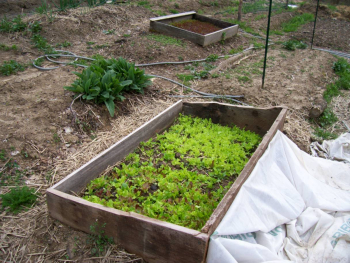 Certain plantings should be
made in midsummer to provide more fresh food for late fall and, in some
cases, even winter. If the weather is hot and dry, be sure to
water
furrows and drills both before and after planting, and every day until
seeds sprout. Here's how I do it:
Certain plantings should be
made in midsummer to provide more fresh food for late fall and, in some
cases, even winter. If the weather is hot and dry, be sure to
water
furrows and drills both before and after planting, and every day until
seeds sprout. Here's how I do it:
1---Beets --- soak seeds
several hours before sowing;
2---Carrots --- plant all
you have room for, perhaps on the early corn and bush bean sites;
3---Kale;
4---Turnips --- varieties
grown only for tops; Just Right has good top growth plus large white
roots;
5---Lettuce --- one short
sowing. Read
more....
Today was a good day for slow drips of water who dream of being long
and solid.
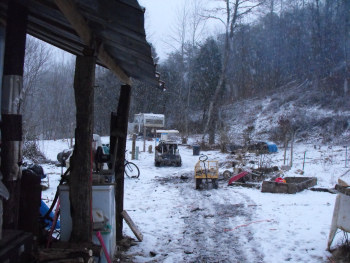 Boy was that groundhog right. I've
always heard that snow grabs nitrogen out of the air, fertilizing
the ground. But is it really true? A search of the internet
turned up these interesting facts....
Boy was that groundhog right. I've
always heard that snow grabs nitrogen out of the air, fertilizing
the ground. But is it really true? A search of the internet
turned up these interesting facts....
...snow and rain probably deposit the same amount of nitrogen.
So, rain is the poor man's fertilizer too.
...the amount of nitrogen deposited by rain or snow doesn't depend on
the number of inches of precipitation. In fact, one
study showed that as the amount of precipitation increased, the
concentration of nitrogen in that precipitation decreased. In
other words, rain or snow washes the nitrogen out of the air --- if it
keeps raining or snowing after a certain point, the available nitrogen
up there gets depleted.
So I guess I'll just have to enjoy the beauty of snow and not count on
masses of fertilizer!
Crops
Withstand Light Frosts
Many crops are not affected
by light frosts. Someone once remarked in mid-October how full my
garden still was of green, growing things although all annual flowers
were blackened. Beet and carrot tops, also parsley, were more
luxuriant than in summer, while lettuce, Chinese cabbage and fennel
were thriving in the cool weather. Broccoli started the March
before
in the house, and set out in April had doubled in diameter since it
first matured back in July, and was sprouting all over with side
shoots. Read
more....
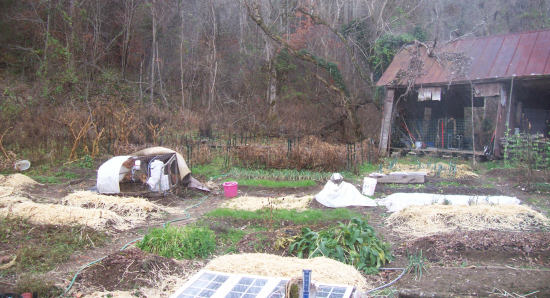
The sun was out for a few hours today proving that winter is slowly
losing its grip on us.
This seems to be the maximum load I can get the golf cart to pull all
the way up our hill.
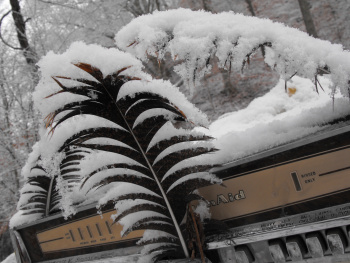 Lest you think the simple life is all farm
fresh eggs and sunny afternoons, I have to admit there are darker
days. I whipped up some tuna salad on Tuesday which really didn't
agree with us --- in fact, it disagreed with me so much that I ended up
throwing up at 3 am in the snow. And at 4 am. And at 10
am. And at noon.
Lest you think the simple life is all farm
fresh eggs and sunny afternoons, I have to admit there are darker
days. I whipped up some tuna salad on Tuesday which really didn't
agree with us --- in fact, it disagreed with me so much that I ended up
throwing up at 3 am in the snow. And at 4 am. And at 10
am. And at noon.
Mark was less visibly affected, though still weakened by the bad
fish. He was able to keep the fire going while all I was able to
do was pull on my coat for the endless treks outside. Thursday,
we were each a bit perkier --- I made it to the sofa instead of
spending all day in bed, and Mark even managed to go get some fresh
wood. But we're both a bit under the weather, which is why my
posts have been a bit low on details. I figured you really don't
want a photo of Lucy excitedly licking up frozen vomit....
Even on the darkest days, though, the simple life doesn't lose its
appeal. Sure, I haven't quite gotten up the strength to heat wash
water to bathe with, but I had two warm cats on my chest Thursday
morning who seem to have imbued me with their energy. It's nice
to know that all we really need is someone able-bodied enough to keep
the home fires burning and feed the animals --- everything else is
optional.
Winter-Harvesting
Crops
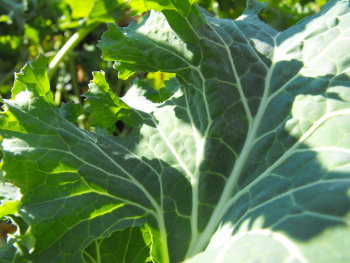 Some few crops not only
survive, but can be harvested all winter. Parsnips taste sweeter
after
a frost, and I've dug up well-preserved carrots in March on the same
day I was planting peas, using them before the weather warmed up.
Egyptian or other perennial bunching onions are the only year-round
vegetable I know of in the North which can be used fresh almost every
day. In winter I use the lower white portions of the stalks ---
there
is not much green growth then --- chopping them into salads, or
flavoring meat dishes and soups. Leeks, so highly esteemed by
gourmets
for their delicate onion flavor, taste best when matured. Frozen
leeks
thaw out perfectly, and a full-grown specimen makes two servings.
Read more....
Some few crops not only
survive, but can be harvested all winter. Parsnips taste sweeter
after
a frost, and I've dug up well-preserved carrots in March on the same
day I was planting peas, using them before the weather warmed up.
Egyptian or other perennial bunching onions are the only year-round
vegetable I know of in the North which can be used fresh almost every
day. In winter I use the lower white portions of the stalks ---
there
is not much green growth then --- chopping them into salads, or
flavoring meat dishes and soups. Leeks, so highly esteemed by
gourmets
for their delicate onion flavor, taste best when matured. Frozen
leeks
thaw out perfectly, and a full-grown specimen makes two servings.
Read more....
The melting of snow goes along nicely with late winter sunsets.
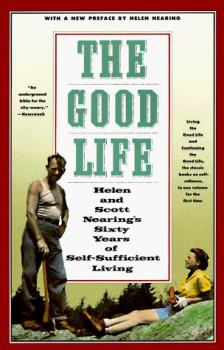
The
Good Life: Helen and Scott Nearing's Sixty Years of Self-Sufficient
Living --- if you like our website, you should go read this book
because it's the real deal. It took me weeks to figure out what I
loved about it, and then it came to me. Of course --- they lived
my dream, and didn't start watering it down as they grew older.
They just kept living it until Scott died at the ripe old age of 100.
Actually, he
committed suicide through a six week fast, which doesn't sound
quite like the good life to me. Other parts of their book also
put me off --- I can understand being a vegan, but I think it's harsh
to call house cats slaves. Read more....
A sizable chunk of winter melted off today revealing some familiar
colors.
I got the picture to the left by inverting the panoramic feature on the
Fuji
Finepix S1000fd.
Someone mentioned that it was Charles Dickens' birthday today, which
should be celebrated by drinking a warm cup of tea or hot chocolate
with someone and sharing which one of his characters you identify with
most and why.

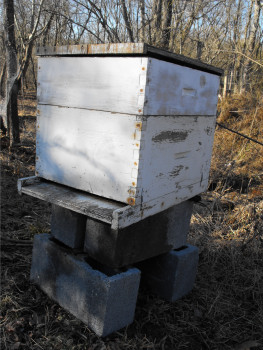 Saturday afternoon was astonishingly
beautiful. The sun pounded down and melted the snow until I had to go outside.
Saturday afternoon was astonishingly
beautiful. The sun pounded down and melted the snow until I had to go outside.
I ended up cleaning up the bee box, scraping off old wax then scrubbing
it down in a washtub of lightly bleachy water. Many people
recommend scorching the old boxes with a blow torch before reusing
them, but I think I might stick to this simpler method and hope I'm not
carrying over any diseases.
The old hive smelled of bee --- honey, beeswax, and sun-warmed
wood. I put the finished product (minus the exterior lid, which
Mark will build later) on cinderblocks at the edge of the yard. I
figure we have a month or two before we can add bees, and I want to
spend some time moving the box around to find the perfect spot --- not
in any direct human paths, but not out of sight; catching the early
morning sun, but a bit protected by late afternoon shade. I also
want to give us some time to get used to the idea of bees on the farm.
While I mused, I took my first outdoor bath of 2009 --- joy and rapture!
These 7 windows have been salvaged from an old high school
and with a little luck will be part of our future experiment in making
a small green house.
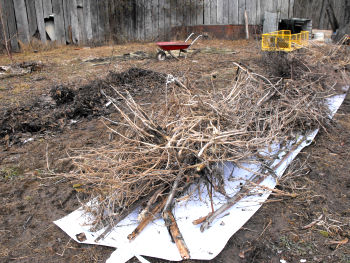 I've been reading Harvey Ussery's permaculture
articles in both Mother Earth News and Backyard Poultry Magazine with
glee, and this
article about creating a forest garden really caught my
fancy. I detest wasted space, and about half of our growing space
right now feels wasted to me --- it's open, weedy areas between young
fruit trees.
I've been reading Harvey Ussery's permaculture
articles in both Mother Earth News and Backyard Poultry Magazine with
glee, and this
article about creating a forest garden really caught my
fancy. I detest wasted space, and about half of our growing space
right now feels wasted to me --- it's open, weedy areas between young
fruit trees.
I've planted vegetables and berries between the trees in one half of
the young orchard, but the other half has soil so terrible that I
figure by the time I get it enriched enough to grow anything
worthwhile, the trees will have closed in over my beds. The area
is also chock full of Japanese Honeysuckle and wild blackberries,
making it difficult to grow anything.
Sunday afternoon I got a bee in my bonnet and decided to experiment in
that awful soil area. I'm trying three different methods (which
you can see above.) Read about the
three beds....
With all of the snow
we've been getting this winter, I thought now might be a good time to
talk about one of my favorite snowy activities --- tracking. I've
decided to call this lunchtime series "Farm Tracking 101" because I'll
cover all of the basics you need to tell your chicken tracks from your
dog tracks and to figure out who's been nosing around your chicken
coop. I'll mention my favorite books and tools later, but for
now, let's dive right in!
Take a look at the two photos below. Yup, I've intentionally made
them too small to tease apart the shape of individual tracks. But
you can probably tell they're made by two different animals,
right? Read
more...
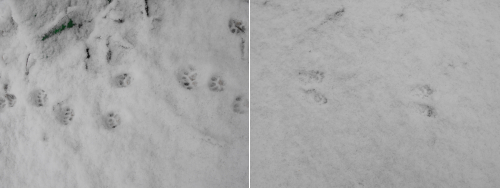
| This post is part of our Farm Tracking 101 lunchtime series.
Read all of the entries: |
Today was a good day for cutting down trees.
It's that time of year when fresh sycamore logs are needed for shitake
mushroom inoculation.
Some folks use oak trees, but we had excellent luck last year using
sycamore.
The two medium sized trees came down with no troubles, and I thank them
for their sacrifice. Anna had me leave a taller than normal stump to
encourage new sycamores to sprout out in the future.
We got them cut up into three foot sections and hauled to the kiddie
pool area where they are patiently waiting for the next step.
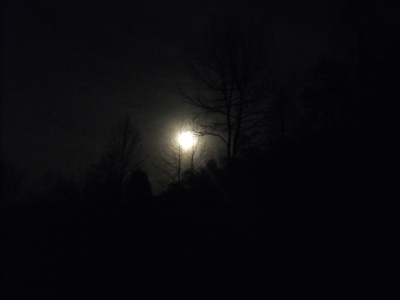 I've felt so alive ever since I recovered from
my bout of food poisoning. The world seems brighter,
clearer...and I want to post constantly. Bear with me. I'm
sure I'll get jaded soon.
I've felt so alive ever since I recovered from
my bout of food poisoning. The world seems brighter,
clearer...and I want to post constantly. Bear with me. I'm
sure I'll get jaded soon. 
Tonight is the full moon and I couldn't resist sharing a few of my
first night photos. I haven't quite figured out all the settings
on the camera, but the photos turned out interesting nonetheless.

Earlier (in daylight), I
watched a Song Sparrow muddle through its first song of the spring as
it perched on a fencepost. The bird seemed a bit confused,
leaving out the distinctive first three notes and settling into the
warbling part with vigor. The cats even got into the spring
weather, begging to be let out repeatedly. No couch sitters on
the farm today!
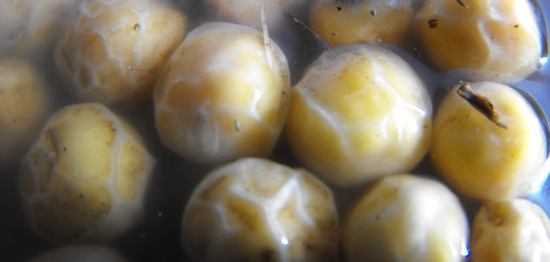
Hen number 6 (the roaming loner) snagged a pea out of my cup as I hoed a planting trench into my pea bed. In chicken world, that pea was obviously quite delicious, so much so that I had to quickly move the rest of my seed peas out of her reach then sneak in the plantings and lure her away with some chicken feed. I'm still not sure she won't go back and dig up my pea seeds, but if not we can expect some crunchy pods in May.
Now that you can tell your
walkers from your bounders, let's take a look at two major walker
groups --- the canines and the felines. You'll have plenty of
opportunity to work on telling them apart when you track your household
pets, and the knowledge you'll gain there will carry over into figuring
out if a fox, bobcat, coyote, or mountain lion is lurking around 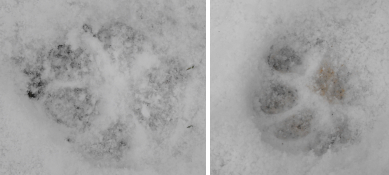 your henhouse.
Basically, large or small, a cat is a cat and a dog is a dog.
your henhouse.
Basically, large or small, a cat is a cat and a dog is a dog.
One of each to get you
started. Which is a cat and which is a dog? Click for the
answer...
| This post is part of our Farm Tracking 101 lunchtime series.
Read all of the entries: |
Here's a
short clip of what the video feature looks like on the Fuji
finepix
S1000fd. It shows what the creek looked like this evening with all
the
snow and ice gone. The camera exports the file as an AVI format which
uploads easily to Youtube, but as you can see the level of detail
leaves something to be desired.
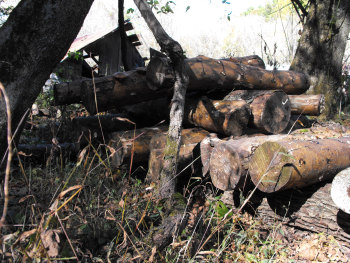 When
we started our shiitake logs two years ago, I didn't do my usual
exhaustive research. Some friends were buying plugs and asked us
if we wanted half of the batch, so we simply followed along
in their wake. Luckily, it all worked out, but now we want to
expand our mushroom production and need to put a bit more thought into
it.
When
we started our shiitake logs two years ago, I didn't do my usual
exhaustive research. Some friends were buying plugs and asked us
if we wanted half of the batch, so we simply followed along
in their wake. Luckily, it all worked out, but now we want to
expand our mushroom production and need to put a bit more thought into
it.
The first choice you hit when you enter the world of backyard mushroom
production is species. We tried one of those box kits of button
mushrooms a couple of years ago, with bad results --- our house was too
cold, so we didn't get many, and it only lasted a few weeks.
Since we don't have scads of free straw, wood chips, or manure, for now
we've decided to stick to growing mushrooms in logs. We have
plenty of logs. Read more....
| This post is part of our Innoculating Mushroom Logs series.
Read all of the entries: |
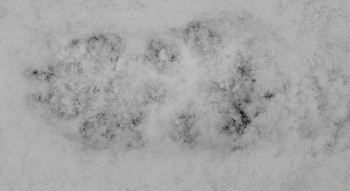 If you guessed dog for yesterday's mystery
track (shown here), you were right. It's actually two tracks on
top of each other, but not exactly registering, making the track look
longer than it actually is and muddying the shape. But the nails
in the front give it away. Domestic dog!
If you guessed dog for yesterday's mystery
track (shown here), you were right. It's actually two tracks on
top of each other, but not exactly registering, making the track look
longer than it actually is and muddying the shape. But the nails
in the front give it away. Domestic dog!
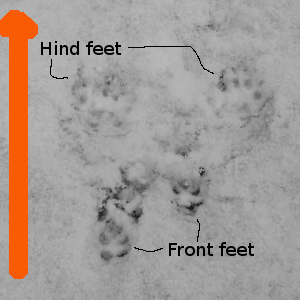 Now to those pesky bounders. When I see
a set of two or four tracks together with a big space between, I
usually haul out my primary tracking tool --- the ruler. The
teensy tiny bounder tracks are shrews, mice, or voles. Next size
up comes chipmunks, then squirrels, then rabbits. Be sure to
measure both the length of the tracks and the space between each set of
tracks --- both are distinctive. Read more....
Now to those pesky bounders. When I see
a set of two or four tracks together with a big space between, I
usually haul out my primary tracking tool --- the ruler. The
teensy tiny bounder tracks are shrews, mice, or voles. Next size
up comes chipmunks, then squirrels, then rabbits. Be sure to
measure both the length of the tracks and the space between each set of
tracks --- both are distinctive. Read more....
| This post is part of our Farm Tracking 101 lunchtime series.
Read all of the entries: |
The mechanical scissors jack is a handy tool almost everybody has tucked away
next to the spare tire in the trunk of your car or truck.
I used ours today to repair some damage to the footbridge that happened during the last
flood.
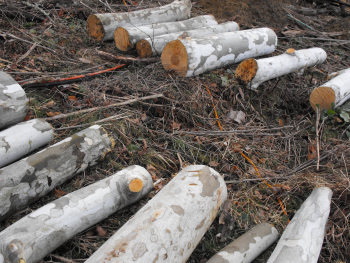 We took advantage of a beautiful day on Monday
to cut down our mushroom trees. Logs for
mushrooms should be cut from healthy living trees so that your spawn
doesn't have any wild fungi to compete with, and February is the
perfect time of year to cut the fully dormant trees.
We took advantage of a beautiful day on Monday
to cut down our mushroom trees. Logs for
mushrooms should be cut from healthy living trees so that your spawn
doesn't have any wild fungi to compete with, and February is the
perfect time of year to cut the fully dormant trees.
The type of tree to cut for your mushroom depends on the species you
want to grow. Read more....
| This post is part of our Innoculating Mushroom Logs series.
Read all of the entries: |
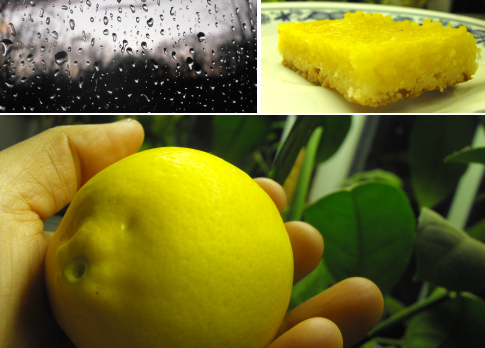
More importantly, though, there was the lemon. Thirteen months ago, Mark's mom gave me a dwarf Meyer lemon --- a cute little sprig of a tree about 18 inches tall. Soon, the tree bloomed, and those lemons grew and grew and grew. I've been watching one turn yellow for the last week and a half, but wasn't sure when it'd be ripe enough to eat. Finally, the tree decided to force my hand --- as I moved a nearby plant, the ripe lemon dropped right off.
One lemon was just enough to make two thirds of the recipe of these Luscious Lemon Bars. They were indeed luscious. Lemons two, three, and four are also nearly ripe, so I'm eying other recipes on this comprehensive Meyers Lemon recipe page. Decisions, decisions!
Once you've learned the
cats, the dogs, and the bounders, you've really learned the most common
tracks. Here are a few more common and/or distinctive tracks you
should be aware of. (I had to forage for some of these
images from the internet --- click to see their source.)
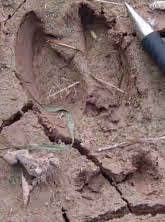
The deer is impossible to confuse with any other species (unless you
live in an area with moose or elk.) The divided hooves may or may
not have small back hooves showing.
Read more....
| This post is part of our Farm Tracking 101 lunchtime series.
Read all of the entries: |
I finished up stage two of the footbridge
repair today by hammering some metal fence posts deep into the ground
to serve as an anchor for the support base.
Some concrete mixed into the holes makes a good bond with the top of
the fence post and hopefully will hold during the next heavy water
incident.
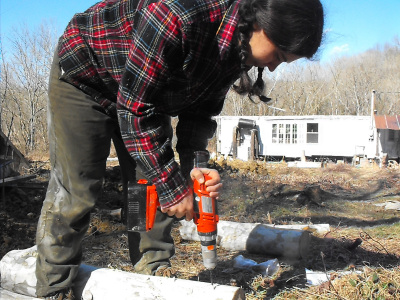 Day-time temperatures staying above 40 F ---
check.
Day-time temperatures staying above 40 F ---
check.
Beeswax hunted down (from a neighbor who keeps bees) --- check.
Time to innoculate the shiitake logs! We actually only
innoculated about a third of the year's logs Thursday since it's very
wrist intensive work. First, drilling holes in a diamond pattern.
Read
more....
| This post is part of our Innoculating Mushroom Logs series.
Read all of the entries: |
 I hope you've had fun
exploring the world of barnyard tracks! If you want to learn more
about tracking, here are two of my favorite tracking books:
I hope you've had fun
exploring the world of barnyard tracks! If you want to learn more
about tracking, here are two of my favorite tracking books:
Peterson's
Field Guide to the Mammals --- This isn't really a tracking book,
but drawings of tracks are scattered throughout. I photocopied
all of the common ones onto one 11X14 sheet of paper ---
perfect for carrying out on the field on a snowy day!
Field
Guide to Tracking Animals in the Snow --- Once again, I photocopied
out one overview page which I carry with me in the field. It
breaks tracks down into walkers and bounders, and then gives you hints
to distinguish species from there.
Enjoy!
| This post is part of our Farm Tracking 101 lunchtime series.
Read all of the entries: |
The guy who owns the small local hardware
store here recommended I use a
spade drill bit to better bore through wood and I'm glad he did.
It really did seem to do a better job on our sycamore mushroom logs
than last year when we used the auger style.
The total cost on the new bit was just under three bucks and I think
I'll store it in a mushroom kit along with the waxy paint brush and the
left over bees wax.
| This post is part of our Innoculating Mushroom Logs series.
Read all of the entries: |
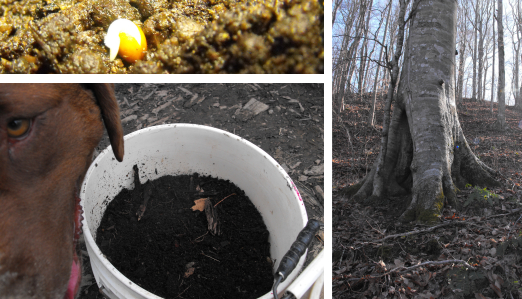
A lot of people screen the stump dirt first, then bake it in the oven on low heat to sterilize it, but I am quite happy with just picking out the big bits of bark and using the stump dirt immediately. I do have to weed out a sprouted Jack-in-the-Pulpit or Greenbriar now and then, but I like having living soil. And, see --- a couple of days later, the broccoli seeds are already sprouting! I just wish we had more of these gracefully aging trees in our forest.
Flickr user kklos2 has an impressive collection
of photos from some of the projects he's completed lately. It's
really inspiring to see so many useful items being made out of scrap
material.
I especially liked his self propelled wheel barrow pictured to the
right here. Images like this can help to release the inner inventor
in us all and maybe provoke something completely different and
wonderful.
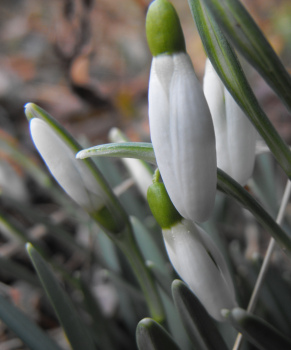 It seems like this winter has been abnormally
cold --- all of the neighbors agree, although I haven't actually
crunched the numbers to find out if it's true. We were all ready
for spring during last week's stunning bout of sun and warmth.
Time to wash loads of laundry and dry them on the line, rip off our
long johns, and bask in the sun.
It seems like this winter has been abnormally
cold --- all of the neighbors agree, although I haven't actually
crunched the numbers to find out if it's true. We were all ready
for spring during last week's stunning bout of sun and warmth.
Time to wash loads of laundry and dry them on the line, rip off our
long johns, and bask in the sun.
Of course, it is still
February and cold weather is with us again. Luckily, spring has
begun and I can let the snowdrops, the singing birds, and the early
morning sun remind me of that fact. Even the daffodils are
starting to poke up. Soon....
There's something about this egg delivery
method that really appeals to me on a minimal level. It reminds me of
my early days when I delivered newspapers on a similar style moped.
It's a good thing he doesn't drive by this farm, because I have a
feeling our dog Lucy might be tempted to follow him for miles in hopes
of some sort of mishap where a few dozen broken eggs might be up for
grabs.
The origin of the picture is unknown, so I guess it's possible I'm
looking at it all wrong as a delivery vehicle and maybe it's a new form
of alternative energy that somehow uses the power of eggs to run the
engine?
I've been wavering all
week on whether to eat our old hens or
not. They stopped laying in the cold this winter, and I figured
since they were over two years old (and a breed of chickens which lays
a lot for a couple of years then slows down markedly), it was time to
put them in the pot. We want to expand our flock this spring, and
it sure would be easier to put the new birds in a pre-made tractor
vacated by the oldsters than to build a new tractor.
Then came the sunny week...and the old hens started to lay. I
figure
they're now laying an egg per bird every second or third day.
Right on the edge of what I consider to be worth feeding them.
So....
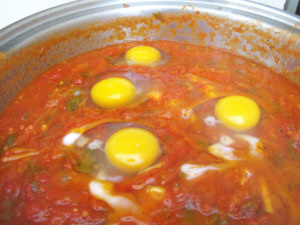 When Daddy sent me his
essay on eating eggs for this week's lunchtime series, I sent him back
the question I've been wondering about for months --- how many eggs can
we safely eat in a week? Like many other people, I had heard that
eating too many eggs caused high cholesterol.
When Daddy sent me his
essay on eating eggs for this week's lunchtime series, I sent him back
the question I've been wondering about for months --- how many eggs can
we safely eat in a week? Like many other people, I had heard that
eating too many eggs caused high cholesterol.
Daddy --- and numerous websites
like this one --- debunked that myth. Eating cholesterol
doesn't raise your cholesterol. Government health agencies are
now putting no limit on the
number of eggs you should eat in a week. Good timing since those
girls are laying up a storm! Guess we can poach some eggs in our
tomato sauce for lunch today.
But there are still some problems with eggs. Stay tuned this week
for an analysis of the problems and solutions.
| This post is part of our Egg Advice lunchtime series.
Read all of the entries: |
Project water line ditch is finally at a two feet depth on
over half of the distance.
The last twelve inches is pure clay, and requires some extra effort
compared to the easy first few layers.
It's good to see the end of a project approaching, even if it might be
done freezing by the time we're finished.
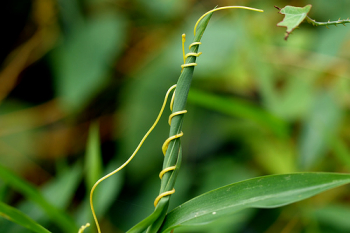 Remember that mini-book I'm
working on? After a bit of a rocky start, I've been whizzing
through it, enjoying spending some time in the scientific literature as
I polish my factoids.
Remember that mini-book I'm
working on? After a bit of a rocky start, I've been whizzing
through it, enjoying spending some time in the scientific literature as
I polish my factoids.
One of the most interesting factoids I've uncovered has to do with
dodder, the orange viney thing on the left. This plant has no
green pigment and thus doesn't make sugars through
photosynthesis. Instead, it twines around nearby plants, pokes
modified roots into their stems, and sucks them dry. Yum!
Dodder is pretty picky, prefering some plants over others for its
dinner, and it seems to know how to grow toward the tastier
specimens. I spent a summer during college working in this very cool
professor's lab, trying to figure out how dodder decides which
plant to twine around. I didn't make any progress, but I ran
across an article recently mentioning that dodder reacts
to airborne chemicals when determining the suitability of a host
plant --- in essence, smelling its prey.
So, next year when the dodder once again wipes out my carrots, I will
at least know that it's a pretty darn cool weed.... (Four and a
half chapters down, two and a half to go!)
Two Problems With Fresh
Eggs
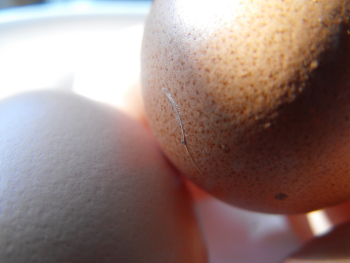 If you have chickens or get
really fresh eggs, you will be familiar
with the first problem. THEY WON'T PEEL! If you want to
make deviled eggs and boil them, removing the shell takes away big
chunks
of the egg white. Not very pretty on the potluck table.
Simple solution.
If you have chickens or get
really fresh eggs, you will be familiar
with the first problem. THEY WON'T PEEL! If you want to
make deviled eggs and boil them, removing the shell takes away big
chunks
of the egg white. Not very pretty on the potluck table.
Simple solution.
Chill the eggs before peeling, either in ice water or by leaving them
in
the refrigerator at least three hours after bringing them to room
temperature in cold water. There is a bubble of air on the wide
end of the egg. Crack it there and remove the peel and the
membrane under the peel. It will now peel like a store-bought egg.
| This post is part of our Egg Advice lunchtime series.
Read all of the entries: |
We finished up the mushroom logs this
afternoon.
One of the neighbors told me how he melted his wax with the bottom half
of a beer can and I'm happy to report it makes cleaning up the mess
just a matter of letting it cool and tossing it in a box for next year.
| This post is part of our Innoculating Mushroom Logs series.
Read all of the entries: |
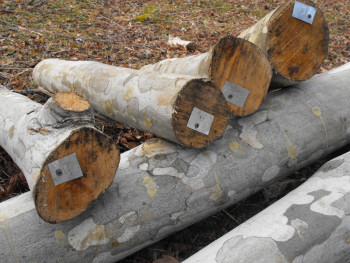 We finished up mushroom
innoculation on Tuesday, more than doubling our number of logs.
Two years ago, I didn't really take any data during innoculation, so I
went a bit overboard this time, recording the number of plugs, mushroom
variety, and the diameter for each log. In a few years, I might
be able to tell if there's an optimal diameter and number of plugs in
order to bear early and/or continue to bear for a long time.
We finished up mushroom
innoculation on Tuesday, more than doubling our number of logs.
Two years ago, I didn't really take any data during innoculation, so I
went a bit overboard this time, recording the number of plugs, mushroom
variety, and the diameter for each log. In a few years, I might
be able to tell if there's an optimal diameter and number of plugs in
order to bear early and/or continue to bear for a long time.
The disappointing part of the day was when I added up the number of
plugs we'd pounded into logs and discovered that Field
and Forest Products had shorted us on every variety! We
ordered 250 plugs of two varieties and 100 plugs of a third variety,
but ended up with only 580 plugs (20 short.) The good news is
that when I called them up and complained (nicely), they immediately
offered to send out "something" to make up for it. I'm excited to
see what our something will be! I thought you all should be
warned that they pack their mushroom plugs by weight, not number, and
seem to lean toward the light side (and that you can get "something"
very easily by calling up when you're short!)
| This post is part of our Innoculating Mushroom Logs series.
Read all of the entries: |
Here's an easy deviled egg
recipe:
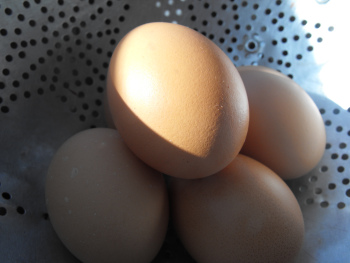
4 hard cooked eggs
2 teaspoons vinegar
1/2 teaspoon salt
1 tablespoon mayonnaise
1/8 teaspoon pepper
1/4 teaspoon dry mustard (or 1 teaspoon prepared mustard)
1 tablespoon cream if using dry mustard
Optional: chopped olives, pickle relish, chopped jalepinos, etc.
Slice eggs lengthwise, remove yolks and hash them till smooth.
Mix well other ingredients. Garnish with paprika or parsley.
| This post is part of our Egg Advice lunchtime series.
Read all of the entries: |
Today was very wet. Constant rain is just what
I needed to troubleshoot the intermittent electrical trouble on the
1990 Ford Festiva.
Luckily today was moist enough to provoke the problem, which is the
engine turning over but not starting, or when it does start it
sometimes stalls.
It seems like I fixed it by unplugging the main distributor wire from
the ignition coil and firmly re-seating it back into place. I drove it
all afternoon in the pouring rain with no other problems. I think I may
add a bead of silicone to the connector cover to decrease the chance of
any more moisture getting inside. The real test will be to see if the
problem doesn't pop up again next week or next month.
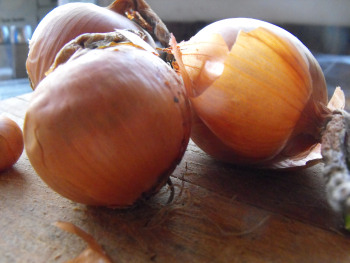 I knew this sad day would finally come, when I
hit the bottom of the bag of homegrown onions. After these three
beauties are eaten, it's back to storebought for the next four to six
months.
I knew this sad day would finally come, when I
hit the bottom of the bag of homegrown onions. After these three
beauties are eaten, it's back to storebought for the next four to six
months.
On a more positive note, the Copra Hybrid onions stored on a dark shelf
in the kitchen for six months with only one onion rotting.
Although about a third of them did
start to sprout a few weeks ago.
We're not producing much of our fruit yet, and our garlic harvest last
year was a bust. I gave away all of our potatoes because I grew
the wrong variety. But beyond those few types, we haven't bought
any vegetables from the store in almost a year. And the freezer
is still about half full!
The Nutrional Problem
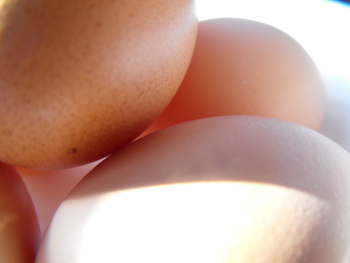 Eggs used to be called "nature's most
perfect food." Today, eggs
are out of balance, like most of our diets, containing little omega 3
fatty acids and an overabundance of omega 6 ones, for the simple reason
that chickens' main food now is corn. There are many ways to
correct this imbalance, such as substituting worms for corn. But
free ranging them or pasturing them is not enough.
Eggs used to be called "nature's most
perfect food." Today, eggs
are out of balance, like most of our diets, containing little omega 3
fatty acids and an overabundance of omega 6 ones, for the simple reason
that chickens' main food now is corn. There are many ways to
correct this imbalance, such as substituting worms for corn. But
free ranging them or pasturing them is not enough.
Studies have found that the omega 3 can be brought back in balance most
simply by adding 5% (five percent) flaxseed to their food ration.
I've
experimented with different ways of doing this other than paying double
for special formula chicken feed. Flax seeds sprout in about a
week,
so sprouts are one way. My chickens love a tray of ground flax
seed
and gobble it up in no time, but they waste a lot picking and flinging
it. What works best for me is to grind the seed (30 seconds in a
food
or coffee mill), add enough water to make a paste, and feed it in a
flat pan. It is gone in a couple of minutes with no waste.
Editor's Note from Anna: My hens
each eat three
quarters of a cup of laying pellets per day, so using Daddy's
math I should be giving each one about two teaspoons of flaxseed mash
per day. Dosages for your hens may vary slightly, but are
probably in the same ballpark. For those of you with a lot of chickens, there are 48 teaspoons in a cup.
| This post is part of our Egg Advice lunchtime series.
Read all of the entries: |
Yesterday's heavy rains gave the footbridge its first serious threat
since last week's attempt at shoring up the base with fence posts and
concrete.
It seems to be holding fine with no shifting or additional erosion.
I'm in the process of researching different designs to hopefully
discover a low budget answer to a wider and taller bridge complete with
handrails and stability.
--- Everett
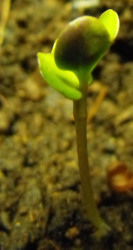 I
took a look at a little essay I wrote in 2004 while dreaming of (and
saving for) land. Here's the short version of what I envisioned
--- eating strawberries and homegrown tomatoes, rescuing minnows out of
buckets of creek water before using it to irrigate the garden, hunting
down fencebreaking cows, and visiting outhouses with a view. As
you can tell, most of the specifics of my dream were limited to buying
the land and moving there. Still, I can definitely say there were
some surprises after arrival.
I
took a look at a little essay I wrote in 2004 while dreaming of (and
saving for) land. Here's the short version of what I envisioned
--- eating strawberries and homegrown tomatoes, rescuing minnows out of
buckets of creek water before using it to irrigate the garden, hunting
down fencebreaking cows, and visiting outhouses with a view. As
you can tell, most of the specifics of my dream were limited to buying
the land and moving there. Still, I can definitely say there were
some surprises after arrival.
When I dreamed of moving back to the land, I always imagined living
here alone. Then Mark fell into my life, and now I can't imagine
doing
it without him. As I've said before, it's amazing to be part of
team working toward a common goal. Good surprise!
My dream timeline of self sufficiency was way off. Read more....
 Daddy's
lunchtime essay this week was short, so I thought I'd take this
opportunity to give a bit of an update on our Avian Aqua Miser.
We've had a couple of months of sales to work the kinks out of our
system, and we have some exciting new products in our chicken waterers store.
Daddy's
lunchtime essay this week was short, so I thought I'd take this
opportunity to give a bit of an update on our Avian Aqua Miser.
We've had a couple of months of sales to work the kinks out of our
system, and we have some exciting new products in our chicken waterers store.
Several of you have asked if we sell the Avian Aqua Miser nipples by
themselves (or if we know of a supplier who would sell directly to
backyard chicken keepers.) We have to buy the nipples in bulk,
but we've decided to offer a 5-pack of chicken nipples in our store for those
of you who buy the DIY kit and want to make lots of Avian Aqua Misers,
or for those of you who might just want to experiment and see if you
can come up with a better waterer.
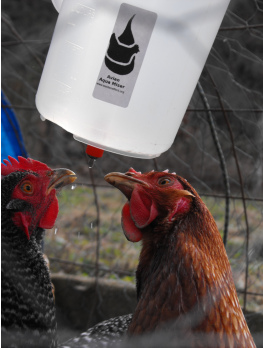
Meanwhile, we lowered
the price on our 3-pack DIY chicken waterer kit --- I finally crunched the numbers and
realized I was charging a higher markup on that product than on the
others. Oops! 
Finally, we've added in a one year, money back guarantee. We're
positive that if you have chickens, you'll love the Avian Aqua Miser,
so we'll take back your waterer no questions asked and refund your
money if you have a problem. (You pay return shipping.)
That's it for advertising for this month! Stay tuned for next
week's installment of Daddy's food and health series --- a focus on
refined sugar and flour.
If I had to be stranded on an island with only
10 tools, a caulk gun of liquid
nails would be in the top 5.
This is an amazing adhesive that works with just about any kind of
surface and when it dries you've got a substance as hard as wood.
It can be found everywhere for just a few bucks per tube, or
if you have a really big project you can get it in a gallon
paint can. I used a tube today on the footbridge and you can
already feel a decrease in the bounce.

The bee hives Mark's friend gave us were almost complete, but none of
them had exterior lids. Friday, we put together a couple of lids
(minus paint and tin, which will come soon.)
 First, I used this very handy
diagram of a Langstroth hive to mark the pieces on a new sheet of
plywood. Then Mark helped me cut them out with the table saw ---
a carefully choreographed dance of him pushing and me pulling, both of
us monitoring the whirring blade and the straight line.
First, I used this very handy
diagram of a Langstroth hive to mark the pieces on a new sheet of
plywood. Then Mark helped me cut them out with the table saw ---
a carefully choreographed dance of him pushing and me pulling, both of
us monitoring the whirring blade and the straight line.
And here's the finished product, screwed together rather than nailed as
suggested in the diagram. I know it's simple, but that's about
the level of my woodworking skills.
In what ways has the "Walden Effect"
life differed from what you originally had envisioned? What was
romanticized that turned out to be totally different or more difficult?
What unexpected pleasures did you find?
--Everett
The concept of "Time Ownership" is one of
the unexpected pleasures that first pops to mind when I think of that
question.
It has taken some considerable distance from my previous corporate
life to fully realize just how little of my time I was able to
save for myself and how much of it was traded away for a paycheck and a
parking spot. I fixed copier machines full time...the words "full time"
being the operative point I'm trying to illustrate here. My time was
full of an endless list of chores that always served the greater good
of the company. My time off always seemed to have an edge to it because
deep in my mind I knew Monday morning was only a day or two away.
Before long you adapt to the less than healthy pace and forget what it
was like to own 100 percent of your day. You eventually convince
yourself that 48 hours on the weekend and a couple of weeks a year is
all you need to survive.
I think I'm in the last stages of my corporate de-programming and
sometimes it's a struggle to decide which hours go where for which
goal, but it's a beautiful struggle that fully belongs to me and at the
end of the day a by-product of that struggle can be felt in the form of
a warm fuzzy feeling in the pit of my stomach as I reflect back on a
noise-free day of getting things done on the farm.
The future looks brighter when you fully own your present, and I believe you
fully own the present by seizing all 24 hours of each day. Maybe that's
what those Latin folks were talking about a thousand years ago when
they were yammering about Carpe Diem?
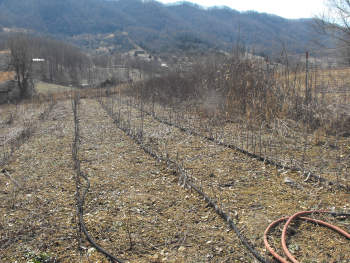 When
Mark and I got married in December, I told everyone that we didn't want
any presents. We try to stay out of the trap of consumerism, and
the truth is that we're not really at the Newlyweds Putting Together A
Household stage where masses of kitchenware, etc., would be useful.
When
Mark and I got married in December, I told everyone that we didn't want
any presents. We try to stay out of the trap of consumerism, and
the truth is that we're not really at the Newlyweds Putting Together A
Household stage where masses of kitchenware, etc., would be useful.
But my friends know me far too well. Two of them already have
found the chink in my armor, dangling fruit trees and bushes in front
of my nose until I snatched them with gleeful thanks.
Yesterday, Mark and I went to pick out two apple trees --- a wedding
gift from his aunt --- from a heritage apple nursery in Lee
County. Despite having no website and no obvious means of
advertising (even his sign on the highway was down), this guy was
obviously doing a booming business. He had over 500 heritage
apple varieties and a thousand plus grafted trees, all eight inches
apart in long, irrigated rows. He does most of his business in
scionwood, though --- selling little branches off of his carefully
collected varieties to folks who want to graft them onto their own
rootstocks. The business seems like a great example of a way to
make good money off of a small lot of land, though the guy also told me
that he works a full time job.
We chose a little Early Transparent (one of my all time favorite apple
varieties) and a Virginia Beauty (a bit randomly because I thought we
were only getting one tree and hadn't done research on a second
variety.) Along with our Stayman Winesap, Winter Banana, and
Striped Rambo at home, this should round out our apple orchard.
Thank you, Sue Ella!
In what ways has the "Walden Effect"
life differed from what you originally had envisioned?
--Everett
My original vision of living off the land
was always based on an experimental foundation. I was already moving
towards a more minimal way of living in the big city environment when I
met Anna. She helped me to see how smooth minimalism can be when mixed
with nature.
I'm still surprised at how delicious and fulfilling it is to be so
closely involved in the personal food production we do here and can't
imagine going back to my old ways of fast food and frozen dinners.
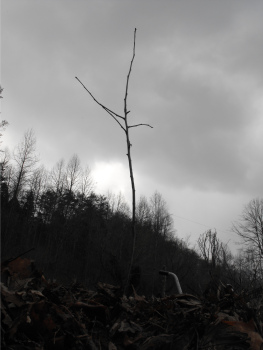 Despite
cold and spitting snow, I spent Sunday afternoon planting the apple
trees. This is the smaller of the two --- the one year old Yellow
Transparent (aka June Apple.)
Despite
cold and spitting snow, I spent Sunday afternoon planting the apple
trees. This is the smaller of the two --- the one year old Yellow
Transparent (aka June Apple.)
I built my usual raised beds,
which seem to be the only way I can get fruit trees to thrive on our
clay soil. The extra drainage and fertility help the trees get
off to a good start, and the size of the bed reminds me where the tree
is so that I don't whack it with a lawn mower, a watering hose, or just
run into it myself.
These two apples fill in my last gaps in the orchard, unless I start to
whittle away at the surrounding woods to create more open space.
I spent several joyful hours developing a better orchard map and
spreadsheet, realizing that if all of my current trees survive, I'll
eventually have tree fruits ripening from June to October. The
pears and two of the apples are good storers, so hopefully they'll keep
in the root cellar until late winter or early spring.
I dream of the day when I can stop buying fruit at the grocery store,
but I know that day will be a few years in the future --- I expect my
first peaches and cherries next year, nectarines and perhaps an apple
in 2011, and full production by 2013.
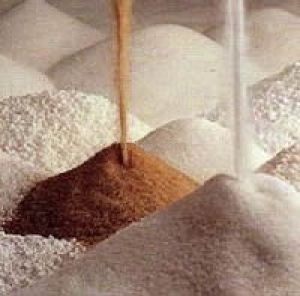 In David Servan-Schreiber's book Anticancer,
we learn that cancer tricks the body to feed it by using the body's
response to inflammation, and that without this inflammation cancer
cannot thrive. What do sugar and refined flour have to do with
inflammation?
In David Servan-Schreiber's book Anticancer,
we learn that cancer tricks the body to feed it by using the body's
response to inflammation, and that without this inflammation cancer
cannot thrive. What do sugar and refined flour have to do with
inflammation?
Plenty, it turns out. Studies of cultures without juveline acne
discovered that diet played an important role in acne
inflammation. By feeding Western adolescents a diet without these
two foods, their acne miraculously disappeared in three months.
The human body developed over many eons eating in a certain way.
Our ancestors' diets were made up of a lot of vegetables and fruit,
with the occasional eggs and meat from wild animals. This diet
began changing with the advent of agriculture around ten thousand years
ago. Up until recently, humans consumed around four pounds of
sugar a year, mostly in the form of honey. Our ancestors
occasionally had some wild grains, but they'd never heard of flour.
In less than two hundred years, the Western diet went from under ten
pounds of sugar eaten per year to over one hundred and fifty pounds.
Editor's
Note from Anna: If you missed the first week of the food and health
series, you can find it in our archives. Daddy
introduced the Anticancer book in part
two.
This post is part of our Food and Health lunchtime series.
Read all of the entries:
|
Electrolyzed
water is gaining some credibility with today's L.A.
Times report. It's still looked down upon in most circles like some
sort of snake oil, but Japan and Russia have been using it as an
alternative to toxic cleaning chemicals for decades.
It costs about a penny a gallon to produce with a machine that will run
you anywhere from 600 to three thousand dollars. The device takes a
small amount of electricity, normal tap water, and some dissolved
salt and produces hydrogen gas and hydroxide ions. One of the resulting
products is 10 times stronger than bleach without harming people or the
environment.
The down side is that it can't be stored for very long and it needs to
be measured to make sure it's at an effective level. The Japanese are
making the most progress by testing its ability as an air filter and
Sanyo is talking about a washing machine that promises to get your
clothes clean without nasty detergents.
Maybe someday in the future we can all replace bleach and other toxic
cleaners with this technology?
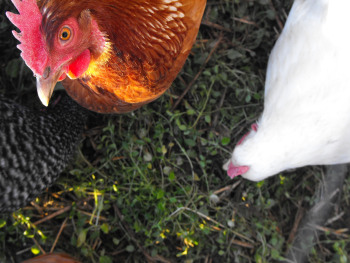 I
noticed that Lucy had jumped on my lettuce bed, ripping the row cover
fabric (bad dog!), so I uncovered some strawberries in order to replace
the fabric. Under the thick row cover, the strawberries were
green and happy, but so was chickweed --- luscious-looking growth that
covered nearly the entire bed. I ripped out the weed and carted
it off to the chickens, who were thrilled to have such a succulent
February feast. I guess now I know why it's called chickweed!
I
noticed that Lucy had jumped on my lettuce bed, ripping the row cover
fabric (bad dog!), so I uncovered some strawberries in order to replace
the fabric. Under the thick row cover, the strawberries were
green and happy, but so was chickweed --- luscious-looking growth that
covered nearly the entire bed. I ripped out the weed and carted
it off to the chickens, who were thrilled to have such a succulent
February feast. I guess now I know why it's called chickweed!
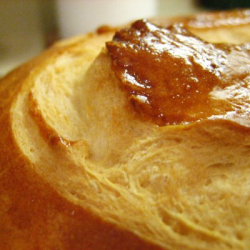 Foods with high glycemic
indexes, such as sugars and white flour, trigger in our bodies a
complex reaction which results in the release of insulin growth factor
(IGF) which stimulates cell growth. Both increased insulin and
IGF from these foods trigger inflammation, making us fatter, more
pimply, and more able to grow tumors into cancer. And diabetic,
by the way. Diabetics have an increased risk factor for cancer.
Foods with high glycemic
indexes, such as sugars and white flour, trigger in our bodies a
complex reaction which results in the release of insulin growth factor
(IGF) which stimulates cell growth. Both increased insulin and
IGF from these foods trigger inflammation, making us fatter, more
pimply, and more able to grow tumors into cancer. And diabetic,
by the way. Diabetics have an increased risk factor for cancer.
I was diagnosed as diabetic over ten years ago. I began
medication and at the same time the hard work of changing how I
eat. My last a-1-c hemoglobin test scored below 6. My
doctor said, if I hadn't been diagnosed, he would say, based on this
test, I wasn't diabetic.
We are experiencing a cancer epidemic in America. Between 1940
and 2000, cancer has increased from less than 60 to 140 cases per
100,000, taking in account the aging of the population. Prostrate
cancer raised by 258 percent in the United States between 1978 and
2000. Breast cancer rates have tripled since WW II.
The good news is, we have eaten our way into this mess, and we can eat
our way out of it!
This post is part of our Food and Health lunchtime series.
Read all of the entries:
|
Six 5 gallon buckets of horse manure, two
50 pound bags of chicken feed, and three sycamore logs for more
mushrooms paints a nice picture of what happened today.
Field
and Forest Products really came through by immediately shipping out
a package of plugs that more than made up for the 20 we were missing
from the first order.
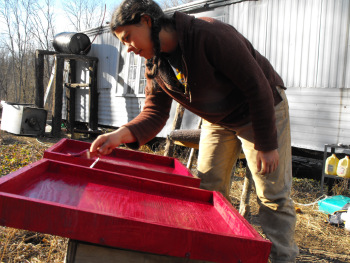 Although our barn is a terrible mess, it's
also chock full of useful supplies. When friends and family start
to throw things away, we instead cart their junk home to toss into a
corner. Someday I'll get it organized, but for now visiting the
barn is a bit like browsing through a crowded antique shop.
Although our barn is a terrible mess, it's
also chock full of useful supplies. When friends and family start
to throw things away, we instead cart their junk home to toss into a
corner. Someday I'll get it organized, but for now visiting the
barn is a bit like browsing through a crowded antique shop.
Tuesday, I headed out to the barn in search of paint for the bee boxes
and came back with a full can of maroon. No white paint to be
found, but I started to ask myself --- why are bee hives painted white?
A quick internet search suggested that white is traditional primarily
to reflect heat in the summer. Since I plan to cover the lids
with reflective tin, I figured I could fly in the face of tradition and
stick with maroon. I wonder what farmers did before google?
 Here are some foods with a high
glycemic index. They should be avoided, reduced in our diets, or
at least balanced by lower glycemic index foods (such as combining
wheat flour with other whole grains):
Here are some foods with a high
glycemic index. They should be avoided, reduced in our diets, or
at least balanced by lower glycemic index foods (such as combining
wheat flour with other whole grains):
- sugar, honey, syrups
- potatoes, mashed potatoes
- corn flakes, rice krispies, all other bleached or sweetened cereals
- james and jellies
- fruit cooked in sugar, fruit in syrup
- sweetened drinks, sodas
- industrial fruit juices
- alcohol (except
during meals)
This post is part of our Food and Health lunchtime series.
Read all of the entries:
|
The TC1840H
garden cart has taken some heavy use this firewood season, and an
important welded spot near the front worked its way loose. Since the
steering bracket is just below the frame I decided to secure
the troubled spot through both pieces to add some additional strength.
It was easy to drill the four holes, although it might be neater to
space them apart just a wee bit more to avoid the washer crowding seen
here in the picture.
Lucy was eager to be the first to test out the new repair, and then she
promptly asked for her evening walk.
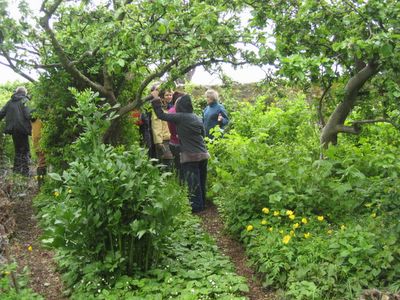 Edible forest gardening ---
the idea of mimicking natural ecosystems while providing tasty food ---
is something I'll probably be talking about a lot here for the next 6
weeks. I ordered three delicious books through interlibrary loan,
and I can already tell that I will be thinking of very little else
until I work my way through those 1,000 textbook-sized pages.
Edible forest gardening ---
the idea of mimicking natural ecosystems while providing tasty food ---
is something I'll probably be talking about a lot here for the next 6
weeks. I ordered three delicious books through interlibrary loan,
and I can already tell that I will be thinking of very little else
until I work my way through those 1,000 textbook-sized pages.
My library hasn't managed to find volume 1 of what seems to be the most
amazing of the forest gardening books, so I've started with volume
2 of Dave Jacke's Edible Forest
Gardens. I've only flipped through, looking at the
pictures, and then read the first 30 pages, but already I can tell that
this book will be my new religion. The ecology is astonishingly
sound and detailed --- not just talking about planting flowers to
attract beneficial insects, but listing which plants to use to attract
which specific beneficials. The 130 pages of plant lists in the
appendices tug at me, making me flip back and forth between lists and
text.
Now my mind is whirling with
ideas that I will try hard not to put into practice until I read at
least a couple of chapters and get more specifics. But
already I'm considering....
| Don't miss our related Planning The Forest Garden lunchtime series.
Read all of the entries: |
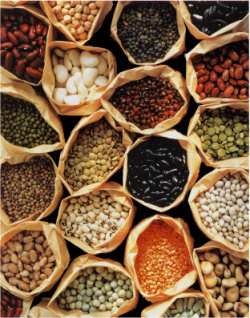 Low Glycemic index foods (eat
all you want):
Low Glycemic index foods (eat
all you want):
- natural sweeteners, agave nectar, stevia, xylitol
- dark chocolate (70%)
- mixed whole grain cereals
- multi-grain bread
- basmati or tai rice
- multigrain pasta and noodles
- quinoa, oats, millet, buckwheat
- nicola potatoes
- lentils, peas, beans
- sweet potatoes, yams
- oatmeal, muesli, All-bran, Special-K
- fruit in its natural state, especially blueberries, cherries, raspberries
- water flavored with lemon, thyme, or sage
- unsweetened green tea
- one glass of red wine a day with a meal
- garlic, onions, shallots
Avoiding candy and snacks
between meals is important because without balancing food they raise
insulin levels, triggering inflammation.
This post is part of our Food and Health lunchtime series.
Read all of the entries:
|
I spent the better part of an hour today
arguing with the nut to the far left here in the picture. I wanted it
to break free and turn freely, but it kept its arms crossed and
insisted on not budging.
The main problem was the lack of leverage. The nut is at the end of the
positive side of the flow and the fact that it wasn't stationary made
the job that much more difficult. After much inner debate I decided to
relent and let the nut stay where it was. I then squashed what was left
of its precious copper connector and bent it in a way so as to fit
snugly in the slot where the bitter end of a thick wire would go in the
new connector. Once tightened down the new configuration seems solid
enough to last another 250 thousand miles.
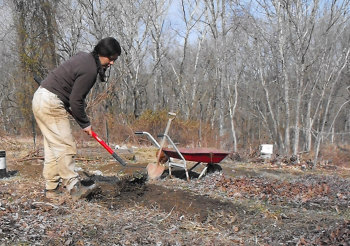 As Mark puts it, once the gardening year
really gets going, it's like riding a full speed locomotive --- good
luck slowing it down or changing course. I can already feel the
gardening locomotive picking up steam, with 32 beds slated to be
planted in March. (We plan to plant about 125 beds of annual
veggies this year, with the vast majority going in on our frost-free
date in May.)
As Mark puts it, once the gardening year
really gets going, it's like riding a full speed locomotive --- good
luck slowing it down or changing course. I can already feel the
gardening locomotive picking up steam, with 32 beds slated to be
planted in March. (We plan to plant about 125 beds of annual
veggies this year, with the vast majority going in on our frost-free
date in May.)
This week, Mark and I went over to our neighbor's house to collect some
horse manure. We sell the neighbors veggies, and they throw their
peels and tops into a pile with their horse manure, which we then
collect in late winter to put back into the garden. Thursday I
raked 11 beds, removing the weeds and working the half-composted manure
and kitchen scraps into the soil. It would be better to let the
manure compost all the way, but at the rate of 2 gallons per 20 square
feet or so, the worms make short work of any organic matter. (I'd
love to double up on my manure application, but those horses will only
give me so much!) Read more....
From Diet
for a Poisoned Planet:
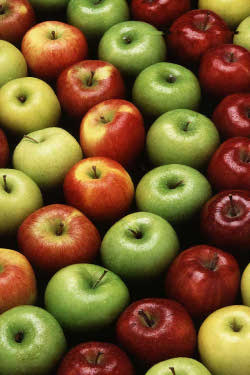 Red Light Foods (all
non-organic in this list):
Red Light Foods (all
non-organic in this list):
- non organic apples (342 pesticide residues in 36 samples)
- raw apricots (157 residues)
- raw celery (240 residues)
- raw sweet cherries (215 pesticide residues in 36 samples)
- collard greens (260 residues in 36 samples)
- raw cucumbers (189 residues)
- grapes
- green peppers (256 residues)
- mixed nuts (246 residues)
- raw peaches (266 residues)
- peanuts (282 residues in 36 samples)
- raw pears (176 residues in 36 samples)
- raw plums (171 residues)
- potatoes (205 residues)
- raisins (200 residues)
- spinach (279 residues in 36 samples)
- raw strawberries (237 residues)
- summer squash (185 residues)
- raw tomatoes (214 residues in 36 samples)
Editor's
note from Anna: Daddy introduced the concept of red and green light
foods in part
5
of his food and health series.
This post is part of our Food and Health lunchtime series.
Read all of the entries:
|
The 1990 Ford Festiva is still chugging along
without that annoying problem of stalling. I'm thinking it may have
been possible that moisture was creeping in through a small crack in
the seal where the new wire seats up with the coil. Hopefully the
silicone I added will keep that area nice and dry.
This Plymouth rock hen expressed some issues with having her picture
taken today, but I explained how it's been weeks since I've had
a good chicken picture and that seemed to put her at ease long enough
to allow a few shots.
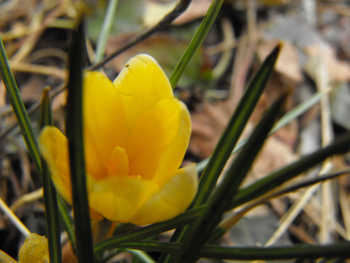 I'm still deeply entrenched in my Edible
Forest Garden book, thinking most recently about pathways. So
much of what I read in the book articulates what I've been learning
over the last couple of years as I lay out paths that do and don't work.
I'm still deeply entrenched in my Edible
Forest Garden book, thinking most recently about pathways. So
much of what I read in the book articulates what I've been learning
over the last couple of years as I lay out paths that do and don't work.
For example --- nodes. The book suggests that when laying out
permanent paths in a garden, you first draw a map with primary
destinations on it, places like compost piles, the entrance to another
part of the garden, and restful nooks. Then connect the dots to
create your main pathways. Lucy taught me this when I laid out a
grid of beds which didn't take into account the diagonal path she
wanted to take to get to the old house (a node) from the trailer
(another node). After many garden beds were trampled along her
diagonal, I gave in and created a main thoroughfare following her path,
with the result that we both got where we were going quicker and with
minimum soil compaction.
Path widths are also essential to plan out in advance. I made the
terrible mistake of making my paths far too narrow (about 1.5 - 2 feet)
in my first gardening enterprise. My new beds in 2008 had wider
paths between them --- about 3 feet to allow easy hauling of weeds and
such in the garden cart. This year, I'm starting to add four main
thoroughfares which are 4 to 5 feet wide, ways to get the golf cart
into each part of the garden.
By the time I finally tricked myself into closing the book last night,
it was late and the first Wood Frogs were chuckling their mating call
in the floodplain with one creaking chorus frog joining in.
Earlier, I stumbled up on the first tiny crocus of the year. Yes,
spring really is on its way!
If I had to choose one type of device that was
the most labor saving for us on this farm it would have to be our
collection of three submersible pumps.
We've had the Ridgid
1 horsepower sump pump for close to two years now and it's really
living up to its name. Our first pump was only a 1/6 horsepower which
was purchased for around 80 dollars, and it did a good job, but for a
little over 200 the Ridgid puts you in a whole new class of water
pumpage. We started out using it for garden irrigation and now have it
doing duty in the hand dug well helping our drinking water make it to a
set of filters inside.
I've got ours adapted to fit a typical water hose and each time I
fiddle with it I'm reminded of the early days when we first got to the
property here and there was no electricity. The baby apple trees needed
to be watered by carrying 5 gallon buckets from the creek, which was
not all that close by. It was a tough job, but a good memory. It's hard
to describe just how great it feels to be a part of testing and building
such an integral part of our infrastructure. I grew up always having
running water just a faucet away and took it for granted every day. Now
I get a rush of accomplishment whenever I hear the trickle and slush of
water making its way to wherever I direct it.
Want more in-depth information? Browse through our books.
Or explore more posts by date or by subject.
About us: Anna Hess and Mark Hamilton spent over a decade living self-sufficiently in the mountains of Virginia before moving north to start over from scratch in the foothills of Ohio. They've experimented with permaculture, no-till gardening, trailersteading, home-based microbusinesses and much more, writing about their adventures in both blogs and books.
